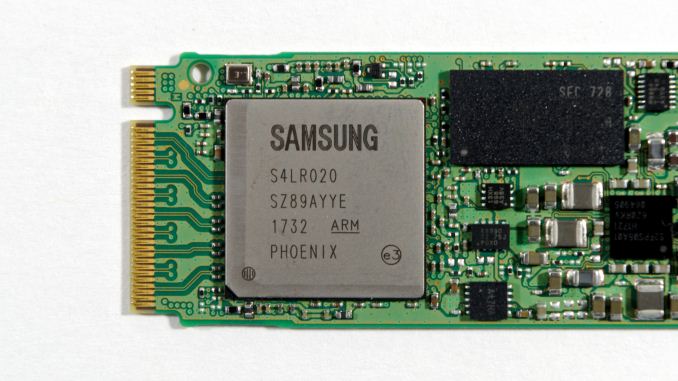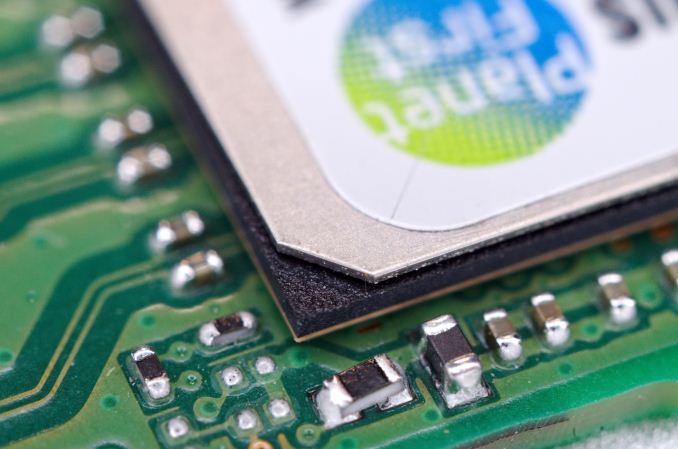The Samsung PM981 SSD Review (512GB, 1TB): Next Generation Controller And 3D NAND
by Billy Tallis on November 30, 2017 9:02 AM EST
Samsung's retail NVMe SSDs, like the 960 PRO, are well-known as some of the fastest SSDs for consumers, but the release of these consumer drives is usually preceded by OEM drives based on similar technology. For example, the 960 Pro is almost identical to the SM961, and the 950 Pro is based on the same controller found in the SM951. The 971 client series was for BGA SSDs, so for the next generation consumer drives, Samsung is expected to use the PM981 controller and NAND as a base for the design. Luckily, the PM981 is the subject of this review.
The Samsung PM981 is Samsung's fourth-generation client PCIe SSD, based on the Phoenix controller and 64-layer V-NAND - both of which have yet to show up in Samsung's retail NVMe SSDs. The PM981 offers both a preview of Samsung's next generation retail NVMe SSDs, and a look at what will likely be the fastest storage available in a high-end notebook computer for the next year.
The Samsung Phoenix NVMe controller has been making appearances at trade shows all year, mostly in the new hot-swappable enterprise form factor PM983 enterprise SSD that Samsung has been promoting for high density solid state storage. Little has been disclosed about this controller other than its name, Phoenix, but it seems to be an incremental evolution of Samsung's client and low-end enterprise SSD controller architecture. With roughly the same package size as the previous generation Samsung Polaris controller, the Phoenix likely retains the same basic configuration of PCIe lanes and NAND and DRAM channels. When Samsung announces retail products based on this controller we should be able to get some information about what's changed internally to allow for improved performance, but for now, even with our testing, we can only speculate. It is clear that Samsung is taking cooling more seriously this time around with a metal heatspreader on top of the package, similar to what i's used on the Silicon Motion SM2260 controller. Samsung has previously used copper foil in the drive stickers to help dissipate heat, so this marks a step up in attempting to cool the controller. Other M.2 PCIe SSD vendors have used that tactic and many have also released drives with more substantial heatspreaders or heatsinks in the future.
The 64-layer 3D TLC NAND Samsung uses in the PM981 has been gradually rolling out across their product lines this year, starting with the Portable SSD T5. Earlier this week we took a look at the Samsung SSD 850 120GB, a new model SATA drive that has been released in the Asian market. The SSD 850 also incorporates the 64-layer 3D TLC, but the small drive capacity and SATA interface were both limiting the extent to which we could measure the performance improvements the new NAND enables.

256GB Package with 8 dies of 64L TLC V-NAND
With a per-die capacity of 256Gb (32GB), it is not that much of a challenge for Samsung to make the 1TB PM981 a single-sided drive by stacking each of the packages with 16 NAND chips each. The 512GB model uses 8-high stacks and is about 0.4mm thinner as a result. The model number stenciled in the circuit board indicates that Samsung does not plan to use this layout for anything larger than 1TB, so if a 2TB model shows up it will probably use a denser layout of four packages rather than switch to 512Gb NAND dies.
| Samsung OEM Client PCIe SSD History | ||||
| Controller | NAND Flash | Notes | Consumer Variant |
|
| XP941 | S4LN053X01 | 2D MLC | PCIe 2.0, AHCI | - |
| SM951 | UBX | 2D MLC | AHCI or NVMe | 950 PRO |
| PM951 | 2D TLC | - | ||
| SM961 | Polaris | 2D & 3D MLC | 960 PRO | |
| PM961 | 3D TLC | 960 EVO | ||
| PM971 | Photon | 3D TLC | BGA SSD, PCIe 3 x2 | - |
| PM981 | Phoenix | 3D TLC | 980 Evo? | |
Samsung's OEM client PCIe SSDs are usually not an exact match for the retail products of the same generation. Their first-generation XP941 used a PCIe 2.0 interface with AHCI instead of NVMe, and never got a retail counterpart. The SM951 and PM951 used planar MLC and TLC respectively, while the later 950 PRO used Samsung's 3D MLC NAND. The SM961 also seems to use planar MLC for its smaller capacities, though the TLC-based PM961 is entirely based on 3D NAND. The Samsung PM971 is an entry-level BGA SSD that may not get a retail counterpart, and if it does it will not fit into either of the existing 9x0 PRO/EVO product tiers.
Based on the model number, the PM981 could be expected to serve as a preview of a 980 EVO product. However, every SSD Samsung has moved to 64-layer V-NAND has used TLC—even the high-end enterprise SSDs. With Samsung's Z-NAND covering the high-performance low-latency niche, Samsung may retire the use of MLC NAND from their more mainstream product lines. If Samsung is not planning to release an enthusiast-oriented Z-NAND product, then the PM981's retail counterpart may have to serve as successor to both the 960 EVO and 960 PRO.
For this review, the primary comparisons will be against the Samsung 960 PRO and 960 EVO, the closest retail equivalents to Samsung's previous generation of client PCIe SSDs. Results for many other PCIe SSDs and a few SATA SSDs are included for comparison. Power measurements are still missing due to a recent equipment failure, but new and much better SSD power measurement equipment is on the way.
| AnandTech 2017 SSD Testbed | |
| CPU | Intel Xeon E3 1240 v5 |
| Motherboard | ASRock Fatal1ty E3V5 Performance Gaming/OC |
| Chipset | Intel C232 |
| Memory | 4x 8GB G.SKILL Ripjaws DDR4-2400 CL15 |
| Graphics | AMD Radeon HD 5450, 1920x1200@60Hz |
| Software | Windows 10 x64, version 1703 |
| Linux kernel version 4.12, fio version 2.21 | |
- Thanks to Intel for the Xeon E3 1240 v5 CPU
- Thanks to ASRock for the E3V5 Performance Gaming/OC
- Thanks to G.SKILL for the Ripjaws DDR4-2400 RAM
- Thanks to Corsair for the RM750 power supply, Carbide 200R case, and Hydro H60 CPU cooler

















53 Comments
View All Comments
mapesdhs - Thursday, November 30, 2017 - link
And Drazick, what do you mean by 2.5" drives? If you're referring to SATA, well then no, it's already at its limit of 550MB/sec, and producing something akin to SATA4 would be pointless when it's also hobbled by the old AHCI protocol.Also, "don't like" is an emotional response; what's your evidence and argument that they're a bad product somehow? Have you used them?
WithoutWeakness - Thursday, November 30, 2017 - link
By 2.5" drives I'm sure he means the same form factor as standard SATA 2.5" SSDs except using a newer, faster connection just like the U.2 connectors that Dan mentioned. We definitely hit the limit of what SATA 3 can deliver and it would be nice to have a new standard that can leverage PCIe NVMe SSDs in a form factor that allows us to use cables to put drives elsewhere in a case for better layouts and airflow. U.2 was supposed to be that connector but there are basically no drives that support the standard and very few boards with more than 1 U.2 port. There are a few adapters on the market that allow you to install an M.2 drive into a 2.5" enclosure with a U.2 connector on it but until motherboards have more than 1 U.2 port it won't be a real replacement for the ubiquity of SATA.msabercr - Friday, December 1, 2017 - link
Actually there are m.2 to U.2 connectors readily available from most MB vendors, and 7mm U.2 datacenter drives are starting to become a thing. See Intel SSD DC P4501. I wouldn't be surprised if AIC disappears after too long. Limiting the power draw would be the major hurdle in creating such drives but it's not impossible. The EDSFF is going to pave the way for many high density compact form factors for NVMe moving forward.sleeplessclassics - Thursday, November 30, 2017 - link
One more thing which I think will be different when these drives are launched as retail devices is the driver support for Phoenix controller. While, it is always difficult to pinpoint the exact bottlenecks on such bleeding edge technology, I think a driver that is better optimized for Phoenix controller will definitely produce better results (ceteris paribus)Also, there have been rumors of QLC-Nand. If that is true, that could be the differentiator between EVO and PRO series.
romrunning - Thursday, November 30, 2017 - link
Yes - QLC... more latency, lower endurance, slower writes - what's not to like? :-SSpunjji - Thursday, November 30, 2017 - link
Lower price..? Higher densities and increased production? That's what it's all about.If 3D QLC performs like 2D TLC then it'll do just fine for mass storage.
mapesdhs - Thursday, November 30, 2017 - link
Good point given the way in which most products seem to be abe to tolerate far more writes than for which they're officially rated, in which case it's likely most users will want something newer long before a QLC product's endurance has been reached. If one is doing something that will drain the endurance a lot faster, then one should be using something more suitable anyway.romrunning - Thursday, November 30, 2017 - link
Sure, but QLC is just like TLC - once you force it on enough people and you say it's "good enough", then the higher-performing but costlier flash (like SLC/MLC) slowly is removed from the product portfolio. I'm not in favor of these race-to-the-bottom "advances", just to reduce the price a bit for hte consumer but more for the mfg. You may get a slight bump in capacity, but for me, the performance/endurance trade-off with a slight reduction in price isn't worth it.Now, I suppose it doesn't matter anymore to me since I'll still be buying the 960 Pro until the Optane 900p reaches better pricing. But the slippery slope you encounter is that new product "advances" are usually better when comapred to to the "current" state of tech. If the current standard is QLC, then the new "improvement" might only be raising it to levels that SLC/MLC were at previously. So the possibility is that it may not be that much of an improvement.
bcronce - Thursday, November 30, 2017 - link
For read heavy mass storage drives, slower writes is fine. SSDs are getting fast enough that the IO or CPU is the bottleneck. Higher read latency for small queues will hurt performance, but not by a whole lot.The endurance is only an issue if you re-write your data a lot, like a paging file or a game drive that sees a lot of updates. A relatively static mass-media drive will probably be just fine.
sleeplessclassics - Thursday, November 30, 2017 - link
Latency can (till some extent) be handled with a bigger dram buffer. Also, controllers are the key here and not the NAND type. Today, even TLC can perform better than MLC/SLC just 2-3 generations ago due to better controllers.A couple of years ago and even last year, 500GB ssd was around $80. If the prices were sane, 64-layer 3D TLC would have been below $50 for sure.
And 96-layer QLC can give real competition to the HDDs.
As for lower endurance, that can be handled by slightly higher provisioning and slower writes....well they would be okay for 95% of the mainstream users.
Enthusiasts have optane and Z-NAND